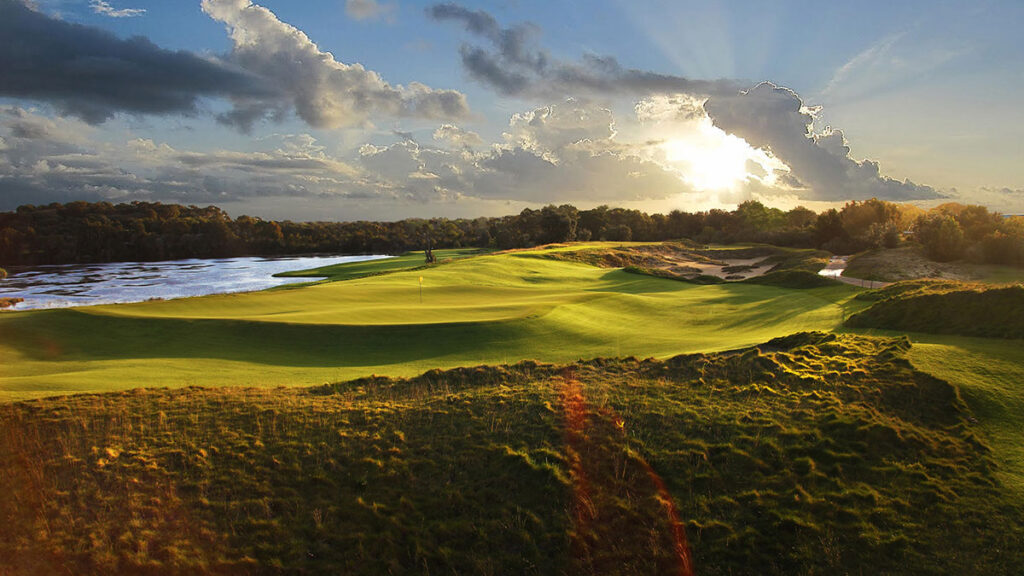This year’s host venues – The Australian Golf Club and The Lakes Golf Club – dish up two vastly different playing experiences. So how will the players handle it?
The toughest part of this year’s dual-course, dual-gender ISPS Handa Australian Open could be predicting the respective winners. Just what will it take to master two golf courses that, despite being only a few hundred metres apart in distance, are seemingly worlds apart in design?
Like last year’s tournament on the Melbourne Sandbelt, players will need to sharpen their logistics as much as their long games as they alternate between The Australian Golf Club and The Lakes Golf Club over the first two days of action.
Unlike last year’s edition at Victoria and Kingston Heath, however, the similarities in playing conditions stop at the respective front gates. What made the challenge adaptable for players in 2022 were the Sandbelt qualities Kingston Heath and Victoria shared – firm, fast fairways and greens, consistent bunkering and breezes. This year’s showdown will be a lottery of sorts, which is what makes it so compelling.
The Australian, a Jack Nicklaus signature design and well versed with the national men’s Open, having hosted it 21 times, offers a peerless American, parkland-style layout just minutes from Sydney’s CBD. It demands good ball-striking and putting nous on greens that, while rolling beautifully – have subtle breaks that are notoriously hard to read.
The Lakes, redesigned in 2007 by former firm Ogilvy Clayton Design, is a seven-time host of the men’s Australian Open. The oft-windswept course boasts 97 bunkers, kikuyu fairways, an abundance of sandy wastelands and many penal water hazards. While it’s certainly more exposed to the elements, it won’t boast the super-slick greens of its neighbour, making scoring strategy between the two courses virtually impossible to compare.
“When they first announced these two courses, I thought, Oh wow! Someone who’s very adaptable will win this tournament,” says former PGA Tour player-turned TV host Paul Gow. “But I think, depending on weather conditions, a really good ball-striker is still going to come up trumps – not so much a good driver of the ball, because I think these two courses are second-shot golf courses.”

History would agree with Gow’s assessment. The previous five winners at The Australian were Matt Jones (twice), Cameron Davis, American Jordan Spieth and Craig Parry, while at The Lakes it was Mexico’s Abraham Ancer, Peter Senior, Greg Chalmers, Geoff Ogilvy and Steve Elkington that had the goods. What were those goods exactly? A blend of experience and strokeplay, not bomb-and-gouge stuff so often seen in other parts of the world.
“I think the fields will be fine this year,” says former European Tour player-turned course architect Mike Clayton. “Players are adaptable and have more information to draw on then they ever have. At the end of the day, they’re just hitting a ball off a lie. The winners will be the ones who don’t really think about it too much.”
The one constant between the two courses, adds Clayton, will be if the weather turns foul.
“Then it becomes a question of: would you prefer a bad day at The Lakes or The Australian?” he says. “Most players would probably take the less-exposed property at The Australian.”
One of those players will no doubt be Australian Golf Club member Jeffrey Guan, one of the country’s hottest young talents who’s ready to put his game to the ultimate test after recently turning professional.
“The biggest challenge this year will obviously be the wind as both courses can be brutal in those conditions,” Guan says. “Some pins may need to be avoided just so we can stop the ball on the green. At the end of the day, everyone has to play the same course in the same conditions but those who hit it straight and accurate will adapt to both courses much easier.”
Pros… they make it sound so simple.
The Australian Golf Club
Men’s (par 72) record: Rod Pampling – 61 (2015)
Women’s (par TBC) record: Jo Anne Carner, Sandra McCaw and Anne Alletson – 74 (1975)
The Lakes Golf Club
Men’s (par 72) record: John Senden – 63 (2011)
Women’s record: N/A

